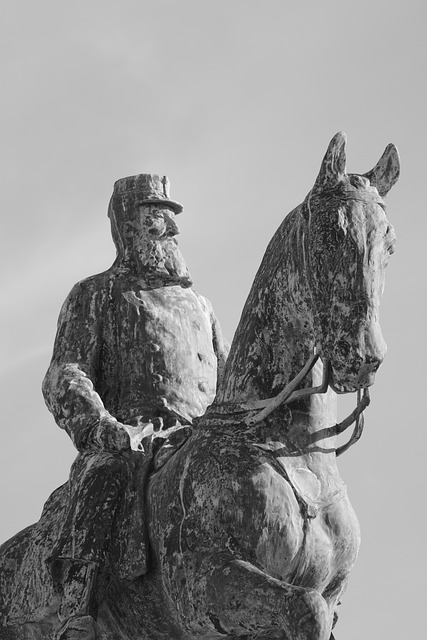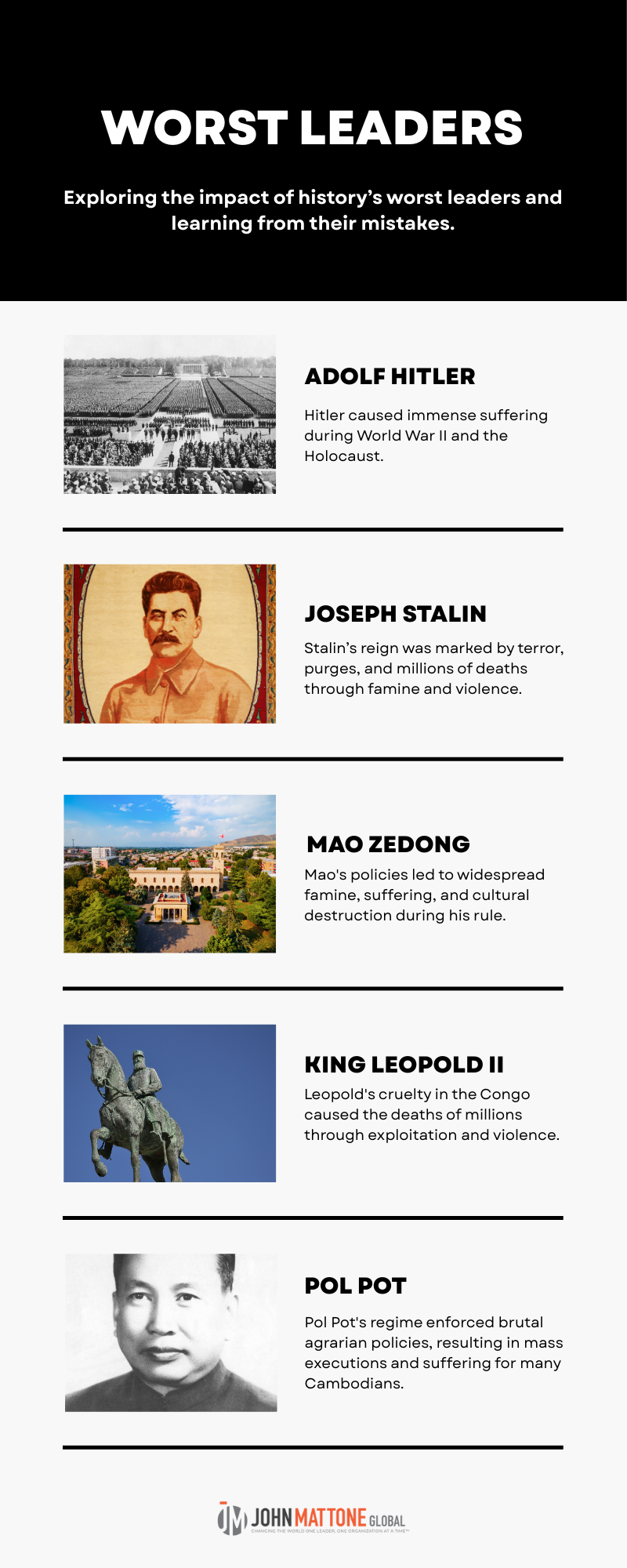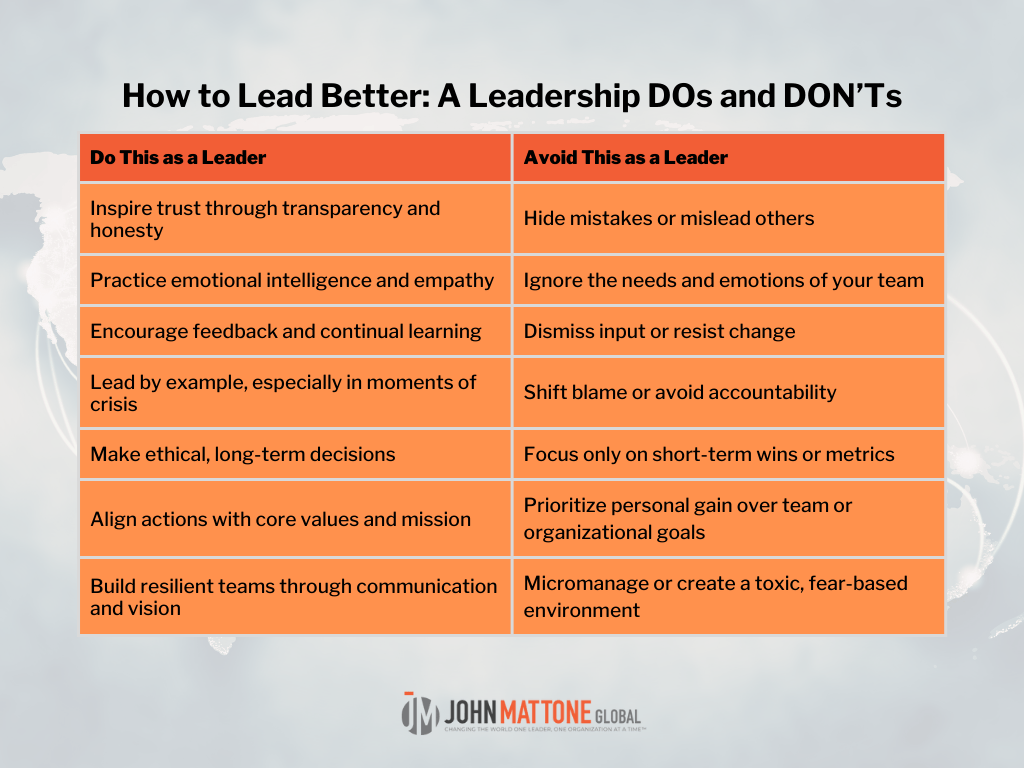As I reflect on history, leaders like Hitler, Stalin, Mao, Leopold II, and Pol Pot reveal how power without character destroys. Their failures remind us that when ego eclipses integrity, devastation follows. True leadership demands strengthening our inner core, humility, courage, and service, so we elevate others rather than diminish them.
As someone who has coached executives at the highest levels for over two decades, I’ve seen how even well-intentioned leaders can slip into toxic behaviors that destroy teams, organizations, and lives. The warning signs are often the same ones displayed by history’s most notorious figures.
That’s why studying history’s worst leaders isn’t just an academic exercise; it’s essential leadership education. By understanding how power corrupts and where leadership goes catastrophically wrong, we can recognize these patterns in ourselves and others before irreversible damage occurs.
In this post, you’ll discover:
- The 5 most destructive leaders in human history and their fatal flaws
- The early warning signs that predict leadership failure
- How to recognize these toxic patterns in modern workplace settings
- Specific strategies to build authentic leadership that inspires rather than intimidates
What Are History’s 5 Worst Leaders?

History’s five worst leaders, Hitler, Stalin, Mao, Leopold II, and Pol Pot, show how an evil leader or political leader, whether a prime minister or head of a democratic people’s republic, collapses when character erodes. Their failures reveal that without inner-core strength, power turns destructive.
True intelligent leadership requires the courage to confront our own capacity for these destructive behaviors. Only then can we choose a different path. One that elevates others rather than diminishing them.
Let’s examine history’s darkest leadership lessons so you can lead with light instead of shadow.
1. Adolf Hitler
Throughout history, humanity has inflicted countless instances of unspeakable cruelty, madness, and horror upon itself. Adolf Hitler, the dictator of Germany from 1934 to 1945, is among the worst single-person disasters to befall the world. Had he never been born, millions would’ve escaped an untimely, cruel death, and history may have taken a radically different path.
- Hitler was a madman bent on world domination. To achieve his megalomaniac goals, he committed genocide and contributed to the deaths of nearly 50 million people worldwide by initiating World War II.
- He caused the collapse of his own country, leaving it with historical traumas it continues to bear today.
- He used his position of authority to bring out the evil in his followers, getting everyday people to commit atrocities that psychologists are still struggling to understand.
- He was responsible for the Holocaust.
- Hitler may have been influential, but he used his influence to poison the minds of those unlucky to fall under his spell.
A research paper on destructive leadership shows that Hitler’s rise stemmed not only from his authoritarian style but from what Padilla, Hogan, and Kaiser call the “toxic triangle”: a destructive leader, vulnerable followers, and a fertile environment.
2. Joseph Stalin
As genocidal maniacs go, soviet dictator Joseph Stalin is one of a handful that fall into Adolf Hitler’s “weight class.” The supreme leader of the Soviet Union from the 1920s to 1953, Joseph Vissarionovich Stalin reigned through terror, political violence, human rights abuses, murder, and extrajudicial killings.
All too happy to work with Hitler when he thought he could benefit from it, Stalin had no qualms about focusing his genocidal ire on the Russian people. He killed more than 20 million people, most of them Russians.
Stalin killed his political opponents and anyone and everyone he suspected of opposing his rule.
- Stalin fought Hitler in World War II, being an uncomfortable ally for the West. That is perhaps the sole reason history has been kinder to him than to Hitler.
- Stalin may have inspired Hitler in many ways. When Hitler came to power in Germany, death camps had long been a reality in Russia.
- Though he may have been an effective administrator, he was also a dismal failure.
As Robert C. Tucker explains in his seminal analysis (The Review of Politics, 1979), Stalin’s paranoid, coercive leadership style, rooted in ideology and fear, created a system defined by purges, repression, and catastrophic governance.
THE INTELLIGENT LEADERSHIP® PLAYBOOK FOR ORGANIZATIONAL READINESS
This playbook outlines practical steps to retain top talent, build bench strength, and foster a high-performance culture. Designed for long-term impact, it’s a strategic guide for aligning leadership development with sustainable business growth.
3. Mao Zedong
Like Hitler and Stalin, Mao Zedong, the all-powerful chairman of the Chinese communist party, came to power during a time that seemed to favor megalomaniacs and genocidal maniacs in leadership positions. Like Stalin, he seemed to prefer killing his own people.
He got busy as soon as he came to power and killed four to six million people within the first four years of his rule. His policies, like the Great Leap Forward and the Cultural Revolution, caused the deaths of around 49 million people.
Overall, Mao contributed to the deaths of about 78 million people, surpassing both Hitler and Stalin.
As Philip Short argues in The China Quarterly analysis “Mao Tse-tung: The Lacquered Image,” Mao’s leadership blended mythmaking, ideological rigidity, and unchecked power, conditions that fueled disastrous campaigns and widespread human suffering.
4. King Leopold II
Belgium’s King Leopold II embodies colonial abuse, plunder, and bloodthirsty robbery. The present-day Democratic Republic of Congo, then a Belgian colony, was the scene of Leopold’s wanton rush to grab as much of the country’s natural resources as possible.
To make matters worse, he treated the natives like disposable slaves and killed around 10 million. His regime was marked by grotesque brutality, including amputations, executions, and forced labor, all in service of enriching his personal fortune.
Under the guise of philanthropy and civilization, Leopold orchestrated one of history’s most gruesome colonial atrocities.
As Kevin Grant shows in The Journal of Imperial and Commonwealth History, Leopold II’s rule in the Congo relied on exploitation, coercion, and violence, an imperial system that produced immense human suffering and lasting trauma

5. Pol Pot
The leader of Cambodia and the infamous Khmer Rouge, Pol Pot modeled his leadership activities after Zedong. In his quest to turn Cambodia’s economy into an agrarian one, he restricted progressive thought, religion, and any activity he deemed a threat to his Marxist ideologies.
Pol Pot murdered more than 25,000 Buddhist monks and destroyed 4,000 monasteries.
Pol Pot’s reign led to the deaths of an estimated 1.7 to 2 million Cambodians, nearly a quarter of the population, through execution, starvation, and forced labor.
His vision of an ultra-communist utopia quickly devolved into one of the most chilling examples of ideological extremism and national self-destruction.
As Ben Kiernan notes in his Yale Genocide Studies Program analysis, Pol Pot’s extremist leadership devastated Cambodia, producing mass executions, starvation, and societal collapse through a ruthless ideological pursuit divorced from humanity.

The Legacy of the Worst Leaders in History
The legacy of history’s worst leaders is a stark reminder that when character collapses, power becomes destructive. Their regimes show how ego, fear, and moral corruption can scar nations for generations, proving that only leaders anchored in integrity, humility, and service leave a legacy worthy of remembrance.
As studies of destructive leadership warn, including Conger’s analysis in Leadership Quarterly (1995), these individuals stand as stark reminders that the misuse of power can unleash devastating consequences that echo across more than a century of world history.
Often remembered among the worst leaders in history, their regimes were built on war crimes, political oppression, and policies so brutal they reshaped entire nations, and in some cases, the entire war efforts of their time.
From the First World War to the Spanish Civil War, history is filled with sobering lessons about what happens when unchecked authority collides with moral corruption and ideological extremism, as illustrated by Florida Tech.
What Is the Impact of Bad Leaders?

The impact of bad leaders is profound: they erode trust, weaken cultures, and create fear-driven environments where people and performance deteriorate. When leaders abandon character and accountability, the damage ripples outward, undermining teams, crippling organizations, and leaving long-term scars that can take years to repair.
One could argue that the people on this list were hardly leaders and were in serious need of business coaching. Mass murder and genocide do not qualify as leadership competencies.
Yet these individuals found themselves in positions of power and became living examples of what authority and disturbed minds can do when leadership is absent
While the historical figures above represent extreme cases of catastrophic leadership, their failures offer lessons that extend far beyond the realm of politics.
Modern Lessons in Catastrophic Leadership: Business and Organizational Failures

Modern leadership failures reveal that catastrophe isn’t limited to history books. When today’s leaders sacrifice integrity, transparency, or sound judgment, organizations crumble. These cases remind us that without strong inner-core values, even the most innovative companies can collapse under the weight of poor decisions and ethical lapses.
We don’t have to go so far back in history to witness the disastrous effects of poor leadership. In recent years, we’ve seen how individuals with significant influence, despite their vision and charisma, can lead their organizations into collapse when integrity and sound judgment are absent.
Corporate Negligence and Leadership Failure: The Boeing 737 MAX Tragedy
The Boeing 737 MAX crisis, a saga that began unfolding in 2018 and continued through 2024 with ongoing litigation and regulatory fallout, offers a sobering corporate case study.
Poor leadership decisions to prioritize speed over safety led to two fatal crashes and the deaths of 346 people, followed by global grounding of the aircraft.
FTX and the Consequences of Ethical Leadership Failure
Another recent example is Sam Bankman-Fried, the former CEO of cryptocurrency exchange FTX, whose leadership downfall in late 2022 shook global financial markets.
Once hailed as a visionary, Bankman-Fried’s reckless decisions and alleged misuse of customer funds resulted in one of the largest corporate collapses in history, wiping out billions in investor wealth and severely damaging public trust in crypto platforms.
11 LAWS OF CHANGE INTELLIGENT LEADERSHIP®
Discover the 11 principles that turn vision into belief, thought into action, and change into lasting transformation. John Mattone’s proven framework challenges you to think differently, feel deeply, and align your inner core with bold, outward results: unlocking the courage, conviction, and consistency that define true leadership.
The Ripple Effect: How Bad Leadership Affects Organizations and Societies
Bad leadership rarely stays contained. Its ripple effects weaken cultures, damage trust, and destabilize both organizations and communities. When leaders abandon character and responsibility, the fallout spreads, eroding morale, impairing performance, and creating long-term consequences that extend far beyond the leader’s immediate circle of influence.
Bad leadership does not exist in a vacuum; its consequences ripple outwards, often devastatingly affecting not just organizations, economies and societies, as illustrated in a research paper on the Impact of leadership on a country’s economic growth.
The decisions made by leaders at the helm of nations, corporations, and military forces shape the course of history, and when those decisions are flawed, the fallout can be catastrophic.
Historical Examples of Leadership Failure
For example, many bad world leaders, such as those who abused power in history, have left lasting scars on their countries. The reign of these leaders often led to economic decline, social unrest, and in some cases, the disintegration of entire nations.
Their inability to lead with vision, honesty, and transparency not only crippled their regimes but also set back their societies by decades.
Once a beacon of civilization, the Roman Empire offers a cautionary tale of how poor leadership can lead to the downfall of even the most powerful entities.
The empire’s decline was fueled by a succession of inept and corrupt leaders who prioritized their ambitions over the state’s well-being, ultimately leading to its collapse.
How Poor Leadership Damages Modern Organizations
In the corporate world, poor leadership can lead to a loss of trust, a decline in employee morale and performance, and significant financial losses.
When leaders fail to inspire and guide their teams effectively, the organization’s productivity suffers, leading to a downward spiral that can be difficult to reverse.
In some cases, the damage is so severe that the organization never recovers, leaving employees, shareholders, and customers to bear the consequences.
Moreover, the impact of bad leadership can extend far beyond the immediate organization or society.
Leaders who fail to manage crises or make ethically sound decisions can cause widespread harm, affecting global markets, international relations, and even regional stability.
50 LAWS OF INTELLIGENT LEADERSHIP®
Discover timeless insights drawn from decades of leadership experience. These 50 Laws challenge you to look inward, think boldly, and lead with integrity. Designed to awaken your potential and elevate your impact, they serve as daily reminders to grow with purpose, act with courage, and inspire lasting transformation.
What Are the Common Traits of Bad Leaders
Bad leaders share predictable traits: weak character, unethical behavior, and an inability to adapt or inspire. When ego overrides integrity and self-awareness is absent, leaders make choices that erode trust, damage cultures, and ultimately derail their own effectiveness.
These traits are not confined to historical figures; they are still relevant today and can be found in modern leaders who abuse power and fail to serve their people responsibly:
1. Incompetence and Lack of Vision
One of the most pervasive traits of poor leadership is incompetence, often accompanied by a lack of vision. Leaders for their roles may be unable to grasp the complexities of the situations they face, leading to poor decision-making that can have disastrous outcomes.
A lack of vision further exacerbates this lack of competence. According to a study published in 2016, leaders struggle to unite or motivate followers or employees toward common goals without a clear and inspiring direction.
2. Abuse of Power and Moral Corruption
Perhaps the most infamous trait of the worst rulers in history is their abuse of power. Leaders who use their positions to enrich themselves or oppress others often leave a legacy of suffering and resentment.
In the corporate world, CEOs and executives who engage in unethical practices, such as embezzlement or exploitation, often cause significant harm to their companies and employees.
3. Failure to Adapt and Innovate
The inability to adapt to changing circumstances and the failure to innovate are critical factors that contribute to the downfall of leaders and their organizations.
History is replete with examples of leaders who clung to outdated methods or refused to adopt new ideas, ultimately leading to their downfall. Leaders who fail to recognize this often find themselves outpaced by more agile competitors.
Leaders who resist change and fail to foster a culture of innovation jeopardize their positions and the future of their organizations.
The most successful leaders understand that adaptability is key to survival in a constantly changing world and that innovation is the driving force behind progress.
How To Avoid the Pitfalls of Bad Leadership

Avoiding bad leadership begins with strengthening your inner core, your character, values, and self-awareness. When leaders commit to reflection, humility, and continuous improvement, they resist ego-driven behaviors and make decisions that elevate people, protect culture, and ensure long-term organizational health.
By learning from the failures of bad leaders, today’s leaders can become positive examples and avoid repeating the same mistakes. Instead, the leader can focus on building a resilient, forward-thinking organization.
Strengthening Self-Awareness to Avoid Leadership Pitfalls
Avoiding the pitfalls of bad leadership begins with a commitment to self-awareness and cultivating a strong inner core. In Intelligent Leadership, I teach leaders to regularly self-reflect, asking themselves tough questions about their values, beliefs, and behaviors.
By focusing on character development, emotional intelligence, and ethical decision-making, leaders can avoid the temptations that lead to corruption and failure.
This continuous improvement process strengthens the leader and builds a resilient, forward-thinking organization capable of weathering the challenges of the modern world.
The Role of Self-Awareness and Continuous Improvement
One of the most critical lessons from history’s leaders is the importance of self-awareness. Leaders who lack this trait often fail to recognize their shortcomings, which can lead to decisions with disastrous consequences.
In both pop culture and historical accounts, we see an endless series of leaders who, blinded by their egos, refused to adapt or improve.
Continuous Improvement as a Leadership Imperative
Self-awareness is not a static trait; it requires continuous improvement. Leaders must regularly evaluate their actions and decisions, striving to grow and adapt as circumstances change.
This commitment to ongoing development is a hallmark of responsible leadership. Without it, leaders risk becoming stagnant, making them more susceptible to the same failures that have brought down many before them.
In the philosophy of Intelligent Leadership, self-awareness and continuous improvement are fundamental to leadership success.
Leaders who prioritize these elements are better equipped to handle the challenges of their roles and rule with integrity, ensuring their leadership has a positive impact on their organizations and societies.
How To Build a Strong Inner Core: The Foundation of Intelligent Leadership

Building a strong inner core begins with strengthening your character, values, and emotional resili
ence. When leaders cultivate self-awareness, courage, and integrity, they create the foundation for sustained excellence, unlocking the ability to inspire others, lead with purpose, and navigate complexity with confidence and clarity.
At the heart of effective leadership lies a strong inner core, a combination of character, values, and emotional resilience. Leaders who neglect to develop this inner strength often make decisions that are self-serving and short-sighted, which can lead to their downfall.
Across the world, from North America, Europe, Asia, Latin America, and North Africa, we see numerous leaders whose lack of a solid inner core led to irresponsible politics, military overreach, and, ultimately, societal instability.
Building Inner Strength Through Character and Virtue
Building a strong inner core is essential for any leader who wishes to lead responsibly. This involves cultivating virtues like empathy and courage, which enable leaders to make ethical decisions and inspire trust among their followers.
Leaders with a strong inner core are better prepared to face adversity and more likely to create a positive, lasting impact on their organizations and societies.
This concept is central to the philosophy of Intelligent Leadership. Leaders with a well-developed inner core can navigate the complexities of modern leadership, from managing military operations to governing in turbulent political environments.
They understand that true leadership is about more than wielding power; it is also about serving others and ensuring the well-being of those they lead.
How To Become an Effective Leader

Becoming an effective leader starts with intentional growth, cultivating emotional intelligence, strengthening character, and committing to continuous improvement. When leaders align their inner core with purposeful action, they inspire trust, elevate others, and create meaningful, lasting impact in their organizations and communities.
Becoming a mature and effective leader is a journey that requires dedication, self-reflection, and a commitment to personal growth.
The lessons from history’s worst leaders offer valuable insights into the pitfalls to avoid, but the path to leadership excellence also involves actively cultivating qualities that drive positive change and inspire others.
1. Cultivating Emotional Intelligence and Empathy
Emotional intelligence and empathy are critical components of effective leadership. Leaders who understand and manage their own emotions and those of others are better equipped to navigate the complexities of leadership.
Leaders who demonstrate empathy are more likely to make decisions that consider the well-being of all stakeholders, rather than pursuing personal or short-term gains.
2. Fostering Innovation and Embracing Change
The ability to innovate and adapt to change is essential for leadership success. Leaders who resist change or fail to foster a culture of innovation risk becoming obsolete as their organizations or nations fall behind more dynamic competitors.
History is filled with examples of leaders who failed because they clung to outdated methods and refused to adopt new ideas, ultimately leading to their downfall.
3. Leading with Integrity and Responsibility
Integrity and responsibility are the cornerstones of effective leadership. Leaders who prioritize these values are more likely to earn the trust and respect of their followers, creating a strong foundation for long-term success.
Responsibility in leadership extends beyond the immediate outcomes of decisions. It encompasses the long-term impact on individuals, organizations, and societies.
The most successful leaders consistently align their actions with their values, leading by example and inspiring others to do the same.
This approach to leadership creates a positive, ethical culture that permeates the entire organization or society, ensuring that the legacy left behind is one of trust, respect, and lasting positive change.
WHAT CAN THE MATTONE LEADERSHIP ENNEAGRAM INVENTORY DO FOR YOU?
Uncover your leadership type and unlock your growth potential with the MLEI. This guide helps you gain an understanding of how the MLEI can help you uncover your strengths, mitigate derailers, and create meaningful change through heightened self-awareness.
Conclusion: The Path to Leadership Excellence
In conclusion, becoming an effective leader involves learning from past mistakes while actively cultivating the qualities that drive success.
By embracing emotional intelligence, fostering innovation, and leading with integrity and responsibility, leaders can avoid the pitfalls that have doomed others and build a legacy of positive, impactful leadership.
The lessons from history’s worst leaders, combined with the positive examples of responsible leadership, provide a roadmap for those who seek to lead with purpose and leave a lasting, positive mark on the world.
To learn more about leadership development, check out my books and JMG’s coaching services.
Schedule Your Free Discovery Session today and take the next step toward becoming the kind of leader who inspires trust, empowers people, and leaves a legacy of positive, lasting impact.

FAQ
Who is the worst leader in history?
Adolf Hitler is widely considered the worst leader in history for triggering World War II and committing some of history’s most horrific war crimes, including the Holocaust.
Who are the worst leaders of all time?
Notable names include Hitler, Stalin, Mao Zedong, Pol Pot, and King Leopold II—leaders responsible for genocide, human rights abuses, and mass death on a global scale.
Who was the worst person in history?
Many view Hitler as the worst person in history due to his role in World War II, the Holocaust, and crimes against humanity.
What leader killed the most people?
Mao Zedong is responsible for the most deaths, with policies causing up to 78 million fatalities, surpassing other world war figures and dictators.
What defines a bad leader?
A bad leader abuses power, ignores ethical standards, causes human rights abuses, and fails to serve the people they lead.
Can a leader commit war crimes without leading a war?
Yes. Leaders like Stalin and Pol Pot committed large-scale war crimes and atrocities during internal purges, not traditional wars.
Were all bad leaders involved in a world war?
No. While many were tied to World War I or World War II, others led during peacetime but still committed severe human rights abuses.
Are there modern examples of poor leadership?
Yes, recent cases like FTX and Boeing show how leadership failure can cause global disruption, financial collapse, and even loss of life.















